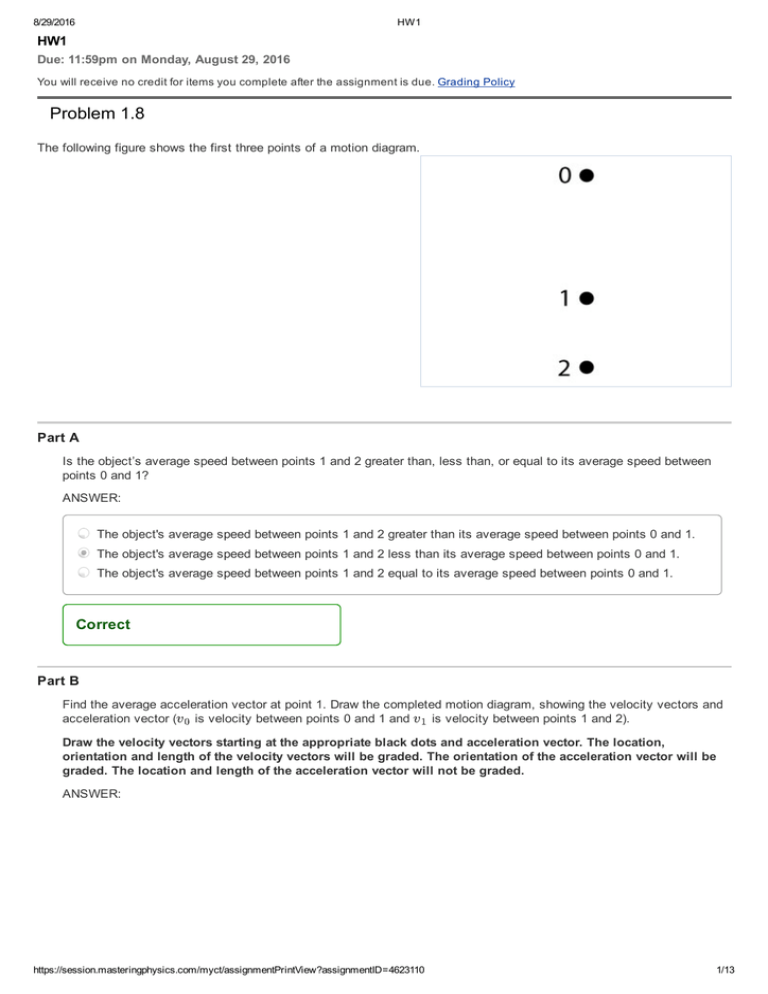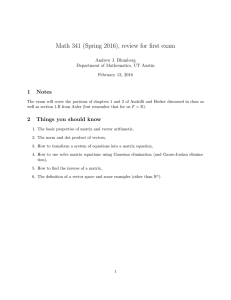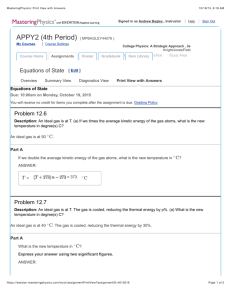Problem 1.8 - Just Question Answer
advertisement

8/29/2016 HW1 HW1 Due: 11:59pm on Monday, August 29, 2016 You will receive no credit for items you complete after the assignment is due. Grading Policy Problem 1.8 The following figure shows the first three points of a motion diagram. Part A Is the object’s average speed between points 1 and 2 greater than, less than, or equal to its average speed between points 0 and 1? ANSWER: The object's average speed between points 1 and 2 greater than its average speed between points 0 and 1. The object's average speed between points 1 and 2 less than its average speed between points 0 and 1. The object's average speed between points 1 and 2 equal to its average speed between points 0 and 1. Correct Part B Find the average acceleration vector at point 1. Draw the completed motion diagram, showing the velocity vectors and acceleration vector (v 0 is velocity between points 0 and 1 and v 1 is velocity between points 1 and 2). Draw the velocity vectors starting at the appropriate black dots and acceleration vector. The location, orientation and length of the velocity vectors will be graded. The orientation of the acceleration vector will be graded. The location and length of the acceleration vector will not be graded. ANSWER: https://session.masteringphysics.com/myct/assignmentPrintView?assignmentID=4623110 1/13 8/29/2016 HW1 Problem 1.10 Part A Figure shows two dots of a motion diagram and vector v 1⃗ . Draw the vector v 2⃗ if the acceleration vector a⃗ at dot 2 points up. Draw the vector starting at the black dot 2. The location and orientation of the vector will be graded. The exact length of your vector will not be graded but the length relative to vector v 1⃗ will be graded. ANSWER: https://session.masteringphysics.com/myct/assignmentPrintView?assignmentID=4623110 2/13 8/29/2016 HW1 Part B Figure shows two dots of a motion diagram and vector v 1⃗ . Draw the vector v 2⃗ if the acceleration vector a⃗ at dot 2 points down. Draw the vector starting at the black dot 2. The location and orientation of the vector will be graded. The exact length of your vector will not be graded but the length relative to vector v 1⃗ will be graded. ANSWER: Problem 1.12 https://session.masteringphysics.com/myct/assignmentPrintView?assignmentID=4623110 3/13 8/29/2016 HW1 A speed skater accelerates from rest and then keeps skating at a constant speed. Part A Select the correct complete motion diagram of the skater. ANSWER: Problem 1.16 A roof tile falls straight down from a two­story building. It lands in a swimming pool and settles gently to the bottom. Part A Select the correct complete motion diagram of the tile. ANSWER: https://session.masteringphysics.com/myct/assignmentPrintView?assignmentID=4623110 4/13 8/29/2016 HW1 https://session.masteringphysics.com/myct/assignmentPrintView?assignmentID=4623110 5/13 8/29/2016 HW1 Consistency of Units In physics, every physical quantity is measured with respect to a unit. Time is measured in seconds, length is measured in meters, and mass is measured in kilograms. Knowing the units of physical quantities will help you solve problems in physics. Part A Gravity causes objects to be attracted to one another. This attraction keeps our feet firmly planted on the ground and causes the moon to orbit the earth. The force of gravitational attraction is represented by the equation F = Gm 1 m 2 r2 , where F is the magnitude of the gravitational attraction on either body, m1 and m2 are the masses of the bodies, r is the distance between them, and G is the gravitational constant. In SI units, the units of force are kg ⋅ m/s2 , the units of mass are kg, and the units of distance are m. For this equation to have consistent units, the units of G must be which of the following? You did not open hints for this part. ANSWER: kg 3 m⋅s2 kg⋅s 2 3 m 3 m kg⋅s2 m kg⋅s2 Part B One consequence of Einstein's theory of special relativity is that mass is a form of energy. This mass­energy relationship is perhaps the most famous of all physics equations: 2 E = mc , where m is mass, c is the speed of the light, and E is the energy. In SI units, the units of speed are m/s. For the preceding equation to have consistent units (the same units on both sides of the equation), the units of E must be which of the following? You did not open hints for this part. ANSWER: kg⋅m s kg⋅m 2 s2 kg⋅s 2 2 m 2 kg⋅m s https://session.masteringphysics.com/myct/assignmentPrintView?assignmentID=4623110 6/13 8/29/2016 HW1 Problem 1.23 How many significant figures are there in the following values? Part A 0.0500 ANSWER: = n Part B 0.02 × 10−12 ANSWER: = n Part C 709.00 ANSWER: = n Part D 2.2 × 105 ANSWER: = n Problem 1.28 Compute the following numbers, applying the significant figure rule adopted in this textbook. Part A 34.0 × 25.5 ANSWER: Part B 34.0­25.5 https://session.masteringphysics.com/myct/assignmentPrintView?assignmentID=4623110 7/13 8/29/2016 HW1 ANSWER: Part C − − − − √34.0 ANSWER: Part D 333.3 ÷ 25.5 ANSWER: Conceptual Question 1.8 Part A Determine the sign (positive, negative, or zero) of the position for the particle in . ANSWER: Negative Zero Positive Part B Determine the sign (positive, negative, or zero) of the velocity for the particle in . https://session.masteringphysics.com/myct/assignmentPrintView?assignmentID=4623110 8/13 8/29/2016 HW1 ANSWER: Zero Negative Positive Part C Determine the sign (positive, negative, or zero) of the acceleration for the particle in . ANSWER: Zero Negative Positive Prelecture Video: Acceleration Click Play to watch the video. Answer the ungraded questions in the video and the graded follow­up questions at right. https://session.masteringphysics.com/myct/assignmentPrintView?assignmentID=4623110 9/13 8/29/2016 HW1 Part A Which of the motion diagrams in the figure below best matches the motion of the bungee jumper shown in the video? ANSWER: A B C D Part B This question will be shown after you complete previous question(s). Part C This question will be shown after you complete previous question(s). Part D This question will be shown after you complete previous question(s). https://session.masteringphysics.com/myct/assignmentPrintView?assignmentID=4623110 10/13 8/29/2016 HW1 Problem 1.19 Part A The length and width of a rectangle are 1.125 m and 0.606 m, respectively. Multiplying, your calculator gives the product as 0.68175. Rounding properly to the correct number of significant figures, the area should be written as ANSWER: 0.7 m2. 0.68 m2. 0.682 m2. 0.6818 m2. 0.68175 m2. Problem 1.35 A jet plane is cruising at 300 m/s when suddenly the pilot turns the engines up to full throttle. After traveling 4.0 km, the jet is moving with a speed of 400 m/s. What is the jet's acceleration as it speeds up? Part A Select the correct pictorial representation. Do not solve this problem or do any mathematics. ANSWER: https://session.masteringphysics.com/myct/assignmentPrintView?assignmentID=4623110 11/13 8/29/2016 HW1 Problem 1.50 Part A Select the correct motion diagram with added acceleration vector. A partial motion diagram is shown in the figure above. ANSWER: https://session.masteringphysics.com/myct/assignmentPrintView?assignmentID=4623110 12/13 8/29/2016 HW1 Part B This question will be shown after you complete previous question(s). Part C This question will be shown after you complete previous question(s). Problem 1.24 Part A The shortest wavelength of visible light is approximately 400 nm. Express this wavelength in centimeters. ANSWER: 4 × 10­5 cm 4 × 10­9 cm 400 × 10­11 cm 4 × 10­11 cm 4 × 10­7 cm Score Summary: Your score on this assignment is 3.8%. You received 5 out of a possible total of 130 points. https://session.masteringphysics.com/myct/assignmentPrintView?assignmentID=4623110 13/13



